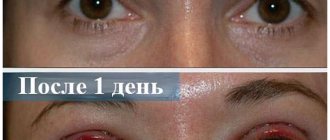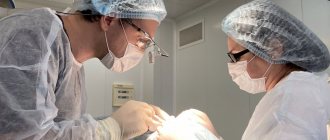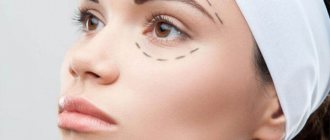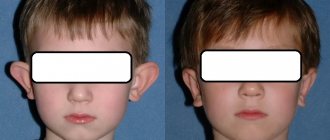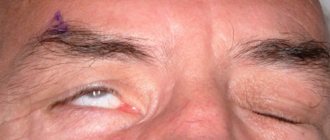Blepharoplasty is a lifting of the upper or lower eyelids, which can tighten the skin in the eye area and restore its tone and former attractiveness. Regardless of the type of plastic surgery or the doctor’s experience, after operations, scars may form after blepharoplasty. We suggest that you familiarize yourself with the peculiarities of the formation of such unpleasant defects, as well as ways to eliminate them.
How are scars formed?
When deciding on any type of blepharoplasty, remember that after making incisions in the epithelium, traces always remain. This is explained by the fact that no matter what the operation, after surgical manipulations there are always stitches and scar tissue is formed. But what the scar will look like after lower blepharoplasty depends on a number of factors:
- correct implementation of the plastic surgeon’s recommendations regarding skin care;
- features of human physiology;
- skill of the plastic surgeon who performed the plastic surgery.
Usually, after blepharoplasty, small scars remain in the form of a thin light strip located in the fold of the eye epithelium. Thanks to the use of modern techniques and discreet incisions, scars become less noticeable to the unprofessional eye.
Scars become a patient's problem only in case of improper care or non-compliance with medical recommendations. Then small traces from operations can lead to an increase in connective tissue and the formation of colloidal scars.
We invite you to see photos of scars after blepharoplasty
Doctors' recommendations for preventing scars
An important rule that helps eliminate unwanted consequences after surgery is to follow the recommendations of the plastic surgeon during the rehabilitation period:
- In the first week after surgery, you should stop reading your favorite books, magazines, and watching television programs;
- do not stretch or rub the epithelium next to the marks from the operation;
- try to avoid exposure to ultraviolet rays on your face as much as possible, wear glasses for protection;
- do not visit solariums, saunas and steam baths (at least 2 weeks after surgery);
- reduce the level of physical activity on the body;
- When taking a bath, try to use warm (preferably cool) water; the seams should not be wet;
- Minimize salt intake to avoid swelling.
The doctor will also tell you about the care products that need to be used during the rehabilitation period.
Caring for seams
After the operation, the eyelids are disinfected and a strip is applied. There is no need to use any ointments before removal; no hardware procedures are performed. All measures to speed up the resorption of scars and remove formed nodules are carried out after removing the threads.
Ointments and gels are prescribed that accelerate the restoration of the skin and prevent the formation of rough scar tissue. Absorbable gels remove redness on the skin remaining after the removal of threads.
Care provides three important functions:
- protection against infection;
- removal of edema;
- stimulation of accelerated healing.
Protection against infection is the use of a patch in the first 3 days after surgery. Do not wash your eyes with tap water, do not go to the sea, swimming pool or sauna. Protect from wind, dust and sun. Swelling is relieved with medications and cold compresses are applied.
Suture healing occurs faster if:
- avoid physical activity;
- touch your eyes less often;
- use eye drops for inflammation;
- apply a cold compress every 10–15 minutes for the first 24 hours;
- Do not pull back your eyelids when instilling drops, place them in the inner corner of the eye.
It is safe to wear makeup 10 days after surgery. Use light, hypoallergenic cosmetics, since the operated area is still sensitive.
If fluid is released from the suture, nausea appears, the temperature rises, or there is severe pain or swelling, this is a reason for an immediate emergency visit to the hospital. You should report any symptoms to your doctor to prevent complications such as infection.
How long will it take for scars to heal?
After blepharoplasty, the patient is usually sent home after 3-5 hours. This is allowed only if there are no complications. The next day after surgery, pain, swelling, bruises and redness in the eye area may appear. Such symptoms are normal and occur due to damage to nerves and blood vessels. To eliminate discomfort, it is recommended to apply cold compresses to the affected areas.
Removal of postoperative sutures is performed on days 5-6, but swelling and bruising may remain for another two weeks. Keloid scars after blepharoplasty take a long time to heal. This happens in several phases:
- Exudative stage. Its duration is 6-8 days. This phase is considered inflammatory, since the eyelids remain red and swelling is observed. During this period, it is recommended to adhere to the rules of seam hygiene. Physical activity is not allowed, as it will lead to the sutures coming apart and causing bleeding. It is also important not to strain your eyes at this stage.
- Granulation of seams. This period is observed for the first 7-14 days after surgical procedures. At the site of the scar, new tissue appears, elastin and collagen fibers are formed. Scars are usually pink in color.
- Scar formation. Scars appear 30-90 days after eyelid surgery. The seam structure becomes more dense. The scar tissue is lightened and smoothed out. This stage is the most important, since if all rehabilitation rules are not followed, hypertrophic or keloid scars will occur.
- The scar fully matures 4-9 months after eyelid surgery. The scar thickens, turns white, evens out, and becomes invisible.
If all medical recommendations are followed, scar healing occurs painlessly for the patient and unnoticed by others.
The location of the scars depends on the type of lift. After plastic surgery of the lower eyelids, they are formed along the visual organ under the ciliary edge. With complete regeneration, they are no different from the structure of normal epithelium. The transconjunctival technique allows you to hide scars, since the incisions are made from the inside. With upper eyelid surgery, the scars are located in the crease above the eyes; they become invisible 14 days after the operation.
You can learn more about scars after blepharoplasty from the video:
How skin is restored
The second day after the operation - the eyelids were very swollen and red. Eyes are sensitive to light.
On the 5th day the redness disappeared. There is still swelling. You can use ointments to reduce swelling and cold compresses.
On the 7th day the sutures are removed. Its location is red, visible to others. Hematomas are still present
On day 8 there is practically no swelling. In some cases, swelling remains for several months. It depends on the type of surgery, skin and other factors.
How to smear scars after blepharoplasty
To avoid overgrowth of connective tissues and to form smooth skin at the scar site, it is recommended to use special silicone-based ointments for scars after blepharoplasty.
Let's consider the most popular means and the principle of their action.
| Name of the drug | Operating principle |
| Dermatix Gel | The ointment is based on silicone, helps soften connective tissues, preventing the formation of uneven, rough scars. Perfectly regulates the water balance of the epithelium. |
| Contractubex | The cream base is allontoin. This is a substance that helps in healing and restoration of damaged tissue. The gel helps soften and moisturize connective tissue and eliminate discomfort. |
| Kelofibrase | The gel, based on components of natural origin, has an anti-inflammatory and moisturizing effect. Helps improve blood circulation in the dermis, normalizes water balance, and this helps in eliminating scar tissue. |
| Scarguard | Liquid structure composition containing silicone. Apply with a special brush. After drying on the eyelids, the drug creates a film layer that retains moisture, which will be needed to soften the scars. |
| Clearvin | Ointment based on herbal ingredients. It contains extracts of medicinal cultures. The product helps in restoration, nutrition, and improvement of blood circulation in the epithelium. |
| Zeraderm | Has a silicone base. Perfectly saturates the epithelium with oxygen, fills it with vitamins, and guarantees rapid recovery. |
| Sledotsid | Excellently relieves inflammation and guarantees tissue regeneration. To achieve the desired result, the composition is applied at least 2 times a day. |
Treatment of scars after blepharoplasty
There are many ways to treat scars caused by blepharoplasty. Let's look at the most popular:
- Laser resurfacing of scars after blepharoplasty. The process of tissue resurfacing after eyelid surgery is carried out using innovative erbium lasers. To completely eliminate scars, you will need from 5 to 7 sessions. After the procedures there is no need for rehabilitation, there are no unpleasant sensations during the session, and the risk of burns is zero.
- Excision of scar tissue. This method is used only in extreme cases, when the scars are too large and very noticeable. Thanks to excision, it will be possible to completely get rid of scars. You should consult your doctor about the possibility of scar excision.
- Use of cryotherapy. This method is based on the use of liquid nitrogen at minimally low temperatures. The technique allows you to lighten the scar and make it thin.
Before deciding to use one or another method of treating scars, it is recommended to first consult with your doctor.
In the photo, a keloid scar is being polished after blepharoplasty:
If there are scars at the suture site
Sutures after surgery are visible only to a plastic surgeon, unless the skin is too thick or they come apart after the procedure.
Fortunately, this rarely happens, only among doctors at the beginning of their career growth. Visible scars are the result of an incorrectly performed procedure, a violation of the blepharoplasty technique, or non-compliance with the surgeon’s recommendations during the rehabilitation period.
In any case, visible seams cannot be left like this. Correction is carried out using hardware techniques. The following techniques will help remove residual scars:
- Mesotherapy. The procedure in the paraorbital area restores the condition of the skin. Mesotherapy refers to injection cosmetology. The procedure involves the introduction of medicinal and homeopathic drugs into the upper layers of the dermis and epidermis. Mesotherapy is not carried out earlier than two weeks after surgery. Enzymes introduced into the layers of the dermis dissolve the tissue. Then ultrasound treatment is carried out with low frequency currents. This effect allows nutrients to penetrate deeper into tissues and speed up the process of tissue repair.
- Laser resurfacing. This technology eliminates unevenness, restores skin color and reduces the level of visibility of the defect. Laser resurfacing does not completely eliminate the remaining scar. Laser eyelid resurfacing may cause redness in the treated area indefinitely. Also, the procedure has many contraindications (infections, pregnancy, dermatitis, psoriasis, diabetes, epilepsy, open wounds, acute inflammatory eye pathologies), so a consultation with a surgeon is required before the procedure. The minimum cost of 1 procedure is up to 4000 rubles.
- Fractional thermolysis. The procedure refers to the destruction of tissue under the influence of high temperatures. The essence comes down to the use of an erbium laser. A laser beam directed at the required area removes the old layer of the epidermis. New cells begin to appear in its place. The effectiveness of the procedure lasts for several years. Fractional thermolysis leads to skin resurfacing and regeneration, the protein sticks together. The result is a lifting effect.
The advantages of fractional thermolysis include:
- safety;
- delicacy;
- physiological;
- long-term preservation of the effect;
- painlessness.
To obtain a visible result, it is enough to carry out 4–6 sessions for the upper eyelids and 3 procedures for the lower skin.
Mesotherapy, laser resurfacing and fractional thermolysis do not require any specific preparation. The procedures are painless and no anesthetics are used.
Injection methods for treating scars
Medicinal injections are one of the most effective methods for eliminating scars. The most popular methods:
- Use of corticosteroids. The substances help reduce the proliferation of connective tissues because they reduce collagen synthesis. The most popular steroid is triamcinolone acetate. It is injected into the scar site after 4-6 weeks. Complications such as muscle atrophy and pigmentation are possible.
- Immunomodulators. A relatively new technique. Interferon is injected into the scar tissue. The procedure is prescribed in sessions every other day for 14 days. After completing this course, 1 injection is given once every 7 days.
- Treatment of scars with blepharoplasty with Botox. The use of botulinum toxin injections helps reduce postoperative scars and makes them thinner.
To achieve the desired result, you need to contact experienced specialists who have encountered similar problems.
Removing stitches
On what day are stitches removed?
Sutures are removed 3–7 days after surgery. A patch is applied in their place for 3 days, and after 4 days everything is removed. The skin then heals on its own and is treated with special ointments or gels to speed up the healing of the sutures.
If the surgeon used self-absorbing sutures, they will not need to be removed. Such threads disappear on their own.
Is it painful to remove stitches after blepharoplasty?
According to patient reviews, the removal procedure is tolerable. If the person wishes, the area will be lubricated with an anesthetic before the threads are removed.
You cannot remove it yourself, pull out the stitches or massage the eyelids before removal.
After the threads are removed, scars form. The skin will be sensitive for approximately 7 days after removal. Soreness is a normal reaction of the body to the removal of a foreign object.
If necessary, the doctor will prescribe painkillers if the pain is unbearable.
Usually, suture removal is painless. Only some time after the procedure may the skin in the injured area be slightly pulled.
How to remove scars after blepharoplasty using traditional methods?
If after blepharoplasty there are long scars, and you are not ready for radical methods, you can use the traditional methods presented in the table:
| Product name | Cooking method |
| Herbal collection | Take dry chamomile, nettle leaves, yarrow, calendula, St. John's wort in equal parts. Pour water (250 ml of boiling water) over the herbs and leave in a heat bath for 65 minutes. After this, the composition is filtered. A piece of linen cloth is soaked in the prepared preparation and applied to the scars. The lotion is kept for 2 hours. |
| Wax-olive mixture | Olive oil (220 ml) is poured into a pan, 50 g of high-quality beeswax is added. The mixture is placed on low heat for 10-12 minutes. After this, the composition is cooled, a linen or cotton napkin is soaked in it, and applied to the scars. The procedure is carried out at least twice a day for 60 days. |
| Parsley tincture | Chop the parsley and pour boiling water (1 cup). The product is left for 15 minutes, then the composition is frozen, divided into small portions. Ice cubes are used to wipe the scar twice a day. Duration of therapy is 3 months. |
| Marshmallow tincture | Finely chop 15 g of marshmallow root, add 250 ml of cold water and leave for 5-7 hours. After the specified time, use the infusion to treat scars every 3-4 hours. In the absence of marshmallow, it is replaced with mint or lemon balm. |
| Melon mask | Take 12-20 melon seeds, 2 eggshells, 5 ml of olive oil. The seeds are dried, crushed, then all components are mixed. The prepared mask is applied to the scar and wrapped with a bandage. The course of treatment is 1 month. |
It is recommended to use traditional medicine only after consulting a doctor. They do not guarantee a quick result, but after a course of treatment they can reduce the appearance of scars.
Reviews from patients about the treatment of scars after blepharoplasty
Review 1, Elena, 34 years old, Moscow:
“After blepharoplasty there were terrible scars. At first I used Contractubex, but it didn’t help me much. The specialist who performed my operation advised me to try laser resurfacing. I've only had 5 sessions and the results are already amazing. If you also have the same problem, don’t be afraid - get laser resurfacing and your appearance will only get better.”
Review 2, Margarita, 45 years old, Murmansk:
“I had blepharoplasty with one of the best surgeons in the city, but the scars still remained. I tried all sorts of ointments, even folk remedies, but the scars were noticeable. On the Internet I came across injection techniques - the administration of corticosteroids. Having received the doctor’s approval, I signed up for manipulation. The process is long and the results are not immediately visible. But after a month, the scars became less noticeable. The technique really works. I recommend!"
